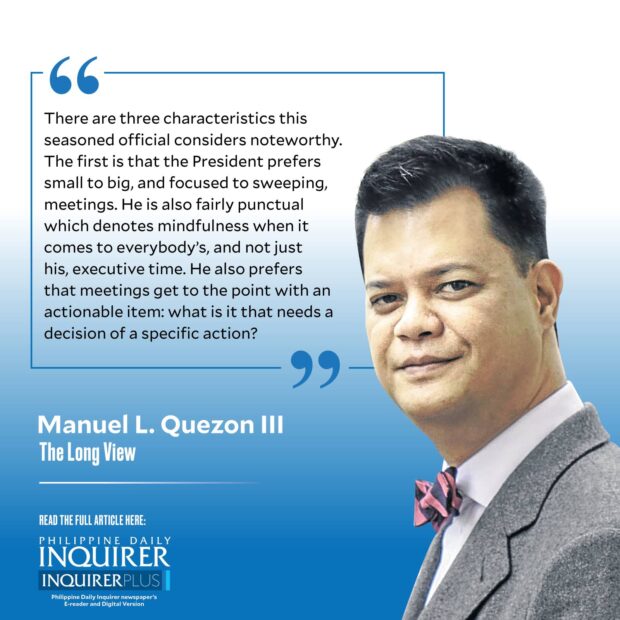
Over the past few administrations, it seems to me, there has been less of an effort to systematically chronicle, much less, analyze, the manner in which our presidents run their administrations. President Cory Aquino commissioned a systematic review of her administration near the end of her term, and, President Fidel V. Ramos was famously prolific in his commentaries. Like her father, President Gloria Macapagal Arroyo studiously and systematically produced a memoir of her time in office in fairly short order after leaving office, and it is likely that had he lived longer, President Benigno Aquino III would have come out with a thorough memoir of his time in public service.
He wasn’t a natural executive and, like so many presidents who came from a legislative background, often chafed at the combination of bureaucratic inertia and endless consultations our system imposes, with a media primed to appeal to this least common denominator in every instance. Yet he was an example of how devotion to duty could impose structure.
The political and institutional, too, are affected in many ways by the personal and this needs careful consideration in reviewing how presidents function—or fail to. A case can be made that our most recent three presidents all subscribe to a uniquely Filipino political and social type: only sons in political families with very strong patriarchs under whose shadow these presidents grew (or were stunted). Here, history weighs heavier than most and likes and dislikes can be inherited or mutated.
No such effort is likely on the part of Presidents Joseph Estrada and Rodrigo Duterte though Aprodicio Laquian came out with an interesting account of his truncated service to Estrada.
Neither have the “Little Presidents,” as executive secretaries have been called since the time of the first one, Jorge B. Vargas, been inclined to write about their periods of service, and for this reason, even commissioned biographies have been economical when it comes to really recording how presidents handled their executive responsibilities. We have a far longer history of executive administration distraction than our neighbors but quite likely a much slimmer volume of serious studies from the perspective of government.
I, for one, can only hope and pray someone like Ronaldo Zamora would do a thorough and candid appraisal of how Palace business is done: in a country where institutional memory is rare, he was immersed in the entire history of the modern presidency, of which his father, as protocol officer to at least seven presidents, was a formidable part: while himself was a wunderkind of sorts in the administration of Ferdinand Marcos Sr. and an ill-fated executive secretary in the Estrada administration. Franklin Drilon, too, with his vast experience and combination of shrewd mess and good humor would be equally interesting in tackling the first Aquino and the Ramos administrations.
These thoughts occurred to me when I ran into two members of the current Cabinet and one of them whom I knew from an earlier administration kindly answered my questions about the President. There are three characteristics this seasoned official considers noteworthy. The first is that the President prefers small to big, and focused to sweeping, meetings. He is the kind who prefers to operate through Cabinet clusters rather than grandly convening the whole which the incumbent finds a waste of time. He is also fairly punctual which denotes mindfulness when it comes to everybody’s, and not just his, executive time. He also prefers that meetings get to the point with an actionable item: What is it that needs a decision of a specific action? I asked if this stemmed from the President’s experience as a local executive but the official candidly said he didn’t want to venture a guess, not having seen the President operate up close when he was still a governor. He did venture the opinion that he finds the President well briefed when they meet; and that the First Lady is not in any way conspicuous in executive affairs.
I ventured an opinion of my own that this is all very interesting not least because it somehow isn’t particularly known by the public: but then again it can be said that very little has been known about the way executive business is conducted these days. To which the official shrugged since he is one of the least political people in public service.
—————-
Email: mlquezon3@gmail.com; Twitter: @mlq3